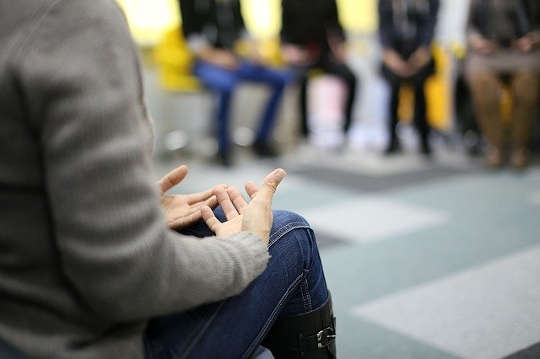
Image by rudamese
Whether unconscious or conscious, we are all hungry for more depth of connection and more purpose. People often choose therapy as a last resort to heal their discomfort. My group therapy practice is built on the concept of taking yourself on, or, as we call it in my group, “work”.
“Doing the work” involves the ongoing commitment to a fierce authenticity. It means having the courage to face yourself with integrity and a willingness to allow the parts of yourself you are reticent to look at (and would be mortified if others saw) to be visible to you and the group.
A “piece of work” involves one person taking centre stage, in the fire of the attention of the rest of the group, looking deeply at a pressing issue in their lives. Each piece of work has its own organic lifespan, but usually lasts about an hour. The person talks about their difficulties, and my job is to bypass the intellectual naming in the participant’s story, stop it becoming a well-played radio broadcast, and find a way to get underneath their words to see the emotional truth underneath.
I do this in a variety of ways. Psychodrama (role play) is my main tool. I use intuition to sense what’s not being said. I notice bodies, breath, a shaking in the hand or a crossing of arms, a facial expression, and I point them out, sometimes showing how these strengthen the person or act as a shield to the truth. Reflecting their physicality encourages them to go deeper when they might want to run away.
I bring them back to their radar by asking them to relate and engage with the group. I often say, “Look around, and see who in the group you trust, like or distrust.” I consider the group to be a hall of mirrors. By bringing the attention of the group to the person in the middle, and the person in the middle bringing their attention to what’s going in the group around them, a field of authenticity is created, where any flattery or falseness would be instantly recognizable. In this sense, “doing the work” is quite different to one-to-one therapy.
For the person doing the work it is like entering into another zone – like bypassing everyday reality as they access their depths. It is usually a nerve-wracking experience, so I create safety – through silence, focus of attention, or facing someone who they know really likes them or who they trust – in order to open doors that may be locked and hidden.
Our depths can show themselves in different ways. Sometimes there is a cathartic outpouring of feelings. Or, much more subtly, a revelation or realization of a personal truth that has been denied and fought with. Sometimes the experience is big and dramatic; sometimes it’s small.
Self-Protection through a Suit of Armour
For good reasons we have learned to construct a suit of armour to protect us from being overwhelmed by the magnitude of painful experience. Perhaps as children we needed to escape from violence, or intrusion, or feeling overwhelmed. This armour serves an important purpose – it protects us – and it’s useful for a warrior to have the capacity for deflection when a situation feels impossible to manage.
The problem is that we have lost the ability to take it off, so the barrier we have erected to protect ourselves deadens our deepest relationships and numbs our sensitivity. A piece of work is usually about carefully dismantling the armour and facing what’s underneath (which is usually far less vile or scary than we expected). Once removed, we can learn the mechanisms for removing it and, importantly, how to consciously put it back on again, in appropriate circumstances.
After the work is done, often there is a feeling of lightness, elation, freedom, happiness and a sense that the foundations have been shaken and reconstituted.
“Work” is done over and over again. My main group takes place one weekend a month for a year – you can’t get away with hiding behind a sophisticated smokescreen in that time. We work and work, building trust, practising the skills in this book, and attaining profound and meaningful growth.
Building Community and Trust
Almost a decade ago I was contacted by a headteacher friend of mine in Yorkshire. She and many of her colleagues were struggling with education cuts, impossible workloads, difficult parents, disruptive students and incapable teachers. They had been given a small amount of money by the education authority to get some support.
In the authority’s mind they would buy in some sort of one-off book to study or a workshop they would attend. What we did was create two sessions to look at conflict and leadership skills. These were greeted so warmly and enthusiastically that we decided we would continue on an ongoing basis.
They came up with a brilliant scheme where each school would contribute money for the sessions and source venues for the meetings. This was a big ask for their limited budgets, but they recognized how essential it was to connect on a regular basis.
Initially, each session explored a different subject, such as leadership, capacity for change and 360-degree feedback (a method for giving anonymous feedback and facilitating communication between all levels in an organization).
For the past five years we have had no agenda. We meet once a term. There are approximately twenty headteachers in this group and normally between twelve and sixteen attend each session.
Very gradually, we learned and practised the skills that can make a lonely and demanding job more bearable. We explored ways of bolstering and aiding each other as the challenging scenarios arise.
If one head was going to have a difficult meeting with their governing body, or have to confront a failing staff member, we would practise a pre-brief and debrief in order to support them through the conversation. Wild human feelings such as anger, hurt, blind rage – inappropriate in a school setting where the individual is in charge of hundreds of children, scores of staff and dealing with many anxious parents – were played out in psychodramas in a safe environment. It could be fury at the general injustice of the school system, frustration at a child who is so damaged that they require constant attention to keep the school structure sound, irritation at a colleague who’s a 9-to-5er and won’t go the extra mile for the school, or having to stay calm while an angry parent throws abuse at them.
Building One-to-One Relationships
They’ve also been building their one-to-one relationships. One of the teachers tried to keep their work and home life separate and has been practising seeking support from her husband without flooding him with constant stress from work.
Everyone in the room faced similar scenarios, and could honour and bear witness to these expressions with compassion. Each individual was met and listened to by like-minded others.
They have learned to show their broken hearts in the knowledge that they have created this safety together. They’ve been able to see their own projections more clearly and to take ownership of their own patterns so they are not run by their unconscious mindsets.
Shedding Layers of Armour
Over the years we’ve been working together, many layers of armour have been shed in the presence of their colleagues. Mutual trust has been earned many times over, and even though their workloads are often crippling, they prioritize coming to this one-day-a-term gathering in the knowledge that if they don’t find a way to upskill themselves and let off steam, they risk the possibility of burnout and overwhelm. Their challenges to each other have become increasingly skillful and perceptive.
They practise slaying their dragons with compassion, learning to tune in to their radars, bearing witness to each other. They talk about their personal mourning and losses; they befriend death. They practise vulnerability. They’ve been learning to choose their battles. They have been undoing the spell that says their limited resources will impact their ability to function.
There is a palpable sense of love in the room. These are highly intelligent individuals who are also emotionally able.
This is a true sangha in the making, and the work has a real effect in their organisation.
Results
“I remembered to breathe before I engaged with an angry parent,” said one headteacher, “and the meeting was productive.”
“I was inspired by our psychodrama to bring in a governor to a meeting of unruly staff who were angry at a decision I’d made (in conjunction with the governors). Their presence provided extra ballast, so there wouldn’t just be an angry rant coming at me.”
You don’t have to literally copy this group of teachers. What is right for this group may not be right for you. The essential point is that they have found a way to take themselves on and they understand that we cannot realize our true potential on our own.
We need other people. It may be in groups, or dedicated friendships. It may be that we need to study a therapeutic or spiritual practice that is pleading to be born from within us.
My understanding always arrives at the same place. Whatever we do in order to break old patterns needs to be practised and a discipline needs to be willingly embraced.
Doing the Work
In my groups we call therapeutic work “doing the work” because none of this is easy. We have to do the work every day. When the soil is cultivated, then the weeds stop growing. In the same way as we create vicious cycles by feeding that which we know is not good for us, we can create virtuous cycles which feed meaning into our lives.
We are never going to arrive at a destination where things are “sorted”. We’re never going to put the world to rights. Life will always change. But if we can truly commit to consciously doing the work, we will build the capacity to thrive in an unstable world.
©2020 by Malcolm Stern with Ben Craib. All Rights Reserved.
Excerpted with permission f the publisher, Watkins,
an imprint of Watkins Media Limited. www.WatkinsPublishing.com
Article Source
Slay Your Dragons With Compassion: Ten Ways to Thrive Even When It Feels Impossible
by Malcolm Stern and Ben Craib
 Ten key teachings from renowned therapist Malcolm Stern. The book, which includes many exercises, is the distillation of over thirty years' experience in the therapy room and shows us that meaning can exist even in the worst tragedy. By creating a set of practices and making them central to our lives we can find passion, purpose, and meaningful happiness while navigating life's darkest moments in such a way that we discover the gold hidden within.
Ten key teachings from renowned therapist Malcolm Stern. The book, which includes many exercises, is the distillation of over thirty years' experience in the therapy room and shows us that meaning can exist even in the worst tragedy. By creating a set of practices and making them central to our lives we can find passion, purpose, and meaningful happiness while navigating life's darkest moments in such a way that we discover the gold hidden within.
For more info, or to order this book, click here. (Also available as a Kindle edition and as an Audiobook.)
Another Book by this author: Falling in Love, Staying in Love
About the Author
 Malcolm Stern has worked as a group and individual psychotherapist for nearly 30 years. He is co-founder and co-director of Alternatives at St James's Church in London and teaches and runs groups internationally. His approach involves finding where the heart is and helping individuals access their truth. His London One Year Group is the centrepiece of his work and has been successfully operating since 1990. In it he creates an environment of trust, integrity and community, where participants can become skilled in relationships, communication and managing difficult conversations. The ultimate learning is to Slay your dragons with compassion. Visit his website at MalcolmStern.com/
Malcolm Stern has worked as a group and individual psychotherapist for nearly 30 years. He is co-founder and co-director of Alternatives at St James's Church in London and teaches and runs groups internationally. His approach involves finding where the heart is and helping individuals access their truth. His London One Year Group is the centrepiece of his work and has been successfully operating since 1990. In it he creates an environment of trust, integrity and community, where participants can become skilled in relationships, communication and managing difficult conversations. The ultimate learning is to Slay your dragons with compassion. Visit his website at MalcolmStern.com/

























